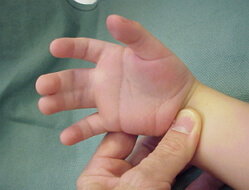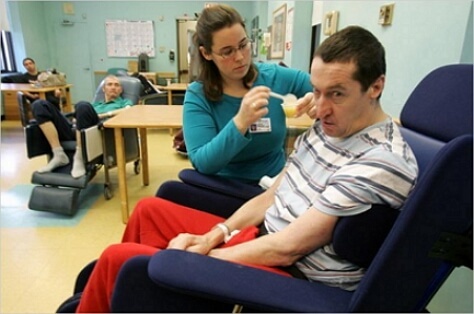Syndactyly
 Syndactyly is the development of a vice that is characterized by the fusion of one or more fingers on the foot or hand with their functional impairments or cosmetic lesions of a certain segment. Syndactyly occurs almost twice as often among boys as girls and on average is 1: 10,000.
Syndactyly is the development of a vice that is characterized by the fusion of one or more fingers on the foot or hand with their functional impairments or cosmetic lesions of a certain segment. Syndactyly occurs almost twice as often among boys as girls and on average is 1: 10,000.
In medical practice, there are several variants of syndactyly, in which there is a division into complete and incomplete fusion of fingers;There is soft tissue or bone fusion;Simple and complex form of lesion phalanx.
Syndactyly causes
To date, the process of forming a fusion of fingers is not fully understood. The hereditary factor is mainly taken into account and it is assumed that syndactyly is one of the forms of limb mutations. Cases have been described that syndactyly is inherited only through the male line and women are not at all carriers of the gene. Hence it can be concluded that the mutant gene is localized in the Y chromosome.
Physiological syndactyly is characteristic of the 4-5th week of fetal development, when the child's brush begins to form. But from the 7-8th week of pregnancy, with normal intrauterine development, finger separation occurs, which is promoted by the rapid growth of the wristbones and a slowdown in the growth of the interdigital tissues. With syndactyly, this does not happen for a number of specific reasons.
Generally syndactyly refers to congenital pathologies, but in 20% of patients, in complex forms, it is considered a hereditary anomaly. More children with syndactyly have also congenital pathologies of the musculoskeletal system. In addition, there is a predominance of fusion of the fingers of the hands over the feet. In this process, not only one arm or leg may be involved, but also in a double ratio of the hand and foot.
In addition to the genetic cause of the pathology of the limbs, there is an effect of toxic substances on the organism of a pregnant woman in the form of drugs, alcoholic beverages and an unfavorable ecological environment, as well as harmful factors from the place of work. All this leads to different types of anomalies and syndactyly one of them.
Syndactylyum symptoms
Since the fusion of the fingers can be soft-tissue and bony, four types of syndactylyl are distinguished. It is cutaneous, membranous, bony and terminal forms of syndactyly. But the fusion of fingers along the length are divided into total, terminal and basal fusion.
Among all forms of syndactyly the skin form is more common than others. It is characterized by a connection between the lateral surfaces of the fingers with the help of soft tissues. With this anomaly, the function of the fingers is disturbed. Therefore, to make movements, it is necessary to make it with both fingers simultaneously.
Syndactyly with membranous form is characterized by the fusion of two or more fingers with a thin membrane that expands in the distal direction and consists of a double layer of skin. With this kind of pathology, individual finger movements are possible, so the functionality of the hands and feet is negligible. Most patients are concerned about cosmetic deficiencies.
The most complex form of the disease is bone syndactyly. In this case, the fusion can touch both the phalanx and the entire finger as a whole. The bony form often passes in parallel with other complex defects of development of bones and soft tissues. When the fusion occurs in the form of cutaneous or osseous forms, the deformations of the fingers of the secondary plan often develop.
When connecting the fingers in the end phalanx area, endodactyl syndrome manifests itself.
The support function for foot syndactyly is disrupted rather infrequently and requires surgical intervention only in cases that are accompanied by a change in the structure of the fingers. But immediate surgical treatment should be performed with the syndactyly of the fingers, as this disease disrupts the functions of the hands and causes noticeable ugliness.
Syndactyly treatment
For inborn syndactyly only an operative method of treatment is characteristic. Combined dermal plastic is used, in which dermotransplants and local tissues are used, which makes it possible to replace the skin defect that occurs after the fingers are separated, regardless of their form of fusion.
For an operative intervention the important moment is the age index, and in what condition are the fused fingers.
For simple forms of congenital pathology, the operation of syndactyly begins at the age of one year. The operation process involves zigzag cuts in the separation of fingers, the formation of interdigital folds, which are located in their own tissues of the hand. Some defects of the lateral surfaces of the fingers are eliminated by grafts taken from the region of the thigh or forearm. Then comes the postoperative period, during which for a month the limb is in a fixed position with a gypsum tire. Two weeks later, a rehabilitative therapy is prescribed, during which the patient attends massage, electrostimulation of the fingers, passes phonophoresis on scars and applications of ozocerite.
Treatment of complex forms of syndactyly recommend starting from the fifth month to the first year of life to prevent progressive processes and prevent the formation of secondary deformations. The main principle of surgical treatment of congenital pathologies with complex forms is the correction of all components of disorders, including the simultaneous removal of splices and absolute replacement of damaged surfaces on severed fingers.
The complex syndactyly of three-phalanx fingers defines four stages for which the process of planning and cutting out the skin material is characteristic, to form interdigital folds, to disconnect congenital fractures, to remove existing deformities, and then to replace wound defects. To form a fold between the fingers, it is taken at the bases of the inner and outer surfaces of the fused fingers, to create tongue-shaped flaps. To eliminate the remaining splices, use zigzag or linear incisions. In the future, if necessary, eliminate the congenital blockade of metacarpal bones and phalanges, disconnect the tendons of the affected fingers.
Surgical interventions that are performed in the surgical treatment of a complex form of syndactyly on I-II fingers, provide for the correction of pathologies in the arrangement of the first finger in order to ensure bilateral girth.
Thus, the timely operation performed gives a positive result and in 80% of the cases the syndactyly is completely disposed of. And only 20% of cases have a negative effect on the functions of the hands and feet.
The postoperative period is one of the most important moments in the repair work of the patient's limbs. For four months the patient uses removable tires, which fix the fingers in the forward position. And also attends the procedures of a physiotherapist, a masseur, is engaged in improving physical therapy, takes mud therapy.



